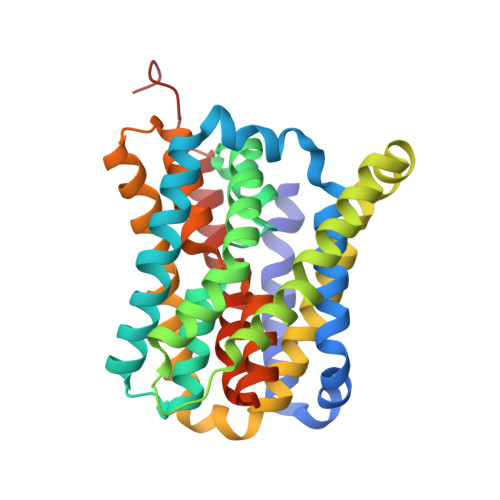An engineered disulfide bridge traps and validates an outward-facing conformation in a bile acid transporter.
Wang, X., Lyu, Y., Ji, Y., Sun, Z., Zhou, X.(2021) Acta Crystallogr D Struct Biol 77: 108-116
- PubMed: 33404530
- DOI: https://doi.org/10.1107/S205979832001517X
- Primary Citation of Related Structures:
6LH1, 7CYG, 7CYK - PubMed Abstract:
Apical sodium-dependent bile acid transporter (ASBT) mediates the uptake of bile acids from the ileum lumen into enterocytes and presents a potential target for the treatment of several metabolic diseases, including type 2 diabetes. It has been proposed that the underlying mechanism for transport by ASBT is an elevator-style alternating-access model, which was deduced mainly by comparing high-resolution structures of two bacterial ASBT homologs (ASBT NM from Neisseria meningitides and ASBT Yf from Yersinia frederiksenii) in different conformations. However, one important issue is that the only outward-facing structure (PDB entry 4n7x) was obtained with an Na + -binding site mutant of ASBT Yf , which severely cripples its transport function, and therefore the physiological relevance of the conformation in PDB entry 4n7x requires further careful evaluation. Here, another crystal structure is reported of ASBT Yf that was captured in a state closely resembling the conformation in PDB entry 4n7x using an engineered disulfide bridge. The introduced cysteine mutations avoided any proposed Na + - or substrate-binding residues, and the resulting mutant retained both structural and functional integrity and behaved similarly to wild-type ASBT Yf . These data support the hypothesis that the PDB entry 4n7x-like structure represents a functional outward-facing conformation of ASBT Yf in its transport cycle.
Organizational Affiliation:
Department of Integrated Traditional Chinese and Western Medicine, State Key Laboratory of Biotherapy, West China Hospital, Sichuan University, Chengdu, Sichuan 610041, People's Republic of China.














